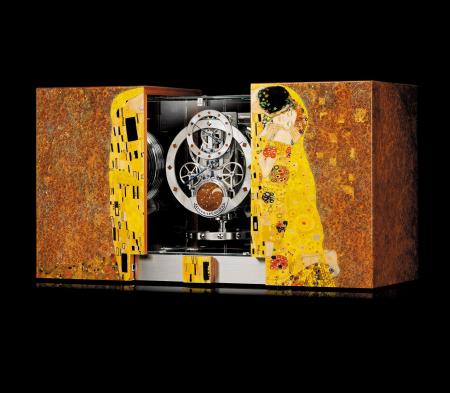Jaeger-LeCoultre honors Gustav Klimt with an exceptional Atmos clock
By MyWatch
Atmos Marqueterie, the epic continues.
In 1904, a Belgian financier, Adolphe Stoclet, commissioned Gustav Klimt to create the mural mosaics of a luxurious mansion he was building in Brussels based on plans by architect Josef Hoffmann. Among the painter’s sketches was the famous painting “The Kiss”, in which he concentrated all his wealth of decorative creativity. Over a century later, Klimt’s work is as vibrantly alive and fascinating as ever.
Jaeger-LeCoultre is dedicating to it a new ten-piece limited edition of the Atmos Marqueterie clock, a perfect embodiment of the Art Nouveau values reinterpreted by the hand craftsmanship traditions of the Manufacture. The cabinet faithfully reproduces “The Kiss” and treats it to the virtuoso skills of rare crafts worthy to match the brilliance of the Austrian symbolist painter.
Over 1,200 tiny pieces of wood, individually cut and either left in their natural state or covered with gold leaf in the manner of Klimt himself, before being glued together, carpet the Atmos cabinet with a splendid entirely hand-made marquetry motif. The concern for detail cherished by the Grande Maison has inspired the artisan to associate various gold colours ranging from yellow to pink, in order to give life to the painting and accentuate its shimmering glow. The most precious varieties of wood mingle their veins and delicate hues in subtly graded shades of brown and orange, against a brown amboyna burl background. Camassari boxwood rubs shoulders with Ceylon lemonwood, and paolo amarela flirts with madrona burl. Maplewood meets pearwood, tulipwood burl is associated with walnut and ashwood burl with Andes boxwood. Above and beyond the technique itself which calls for several hundred hours of work, the artistic flair of the master-marquetry artist plays a determining role in the beauty of the completed work.
Equipped with a discreet mechanical system featuring a button concealed within the motif, the cabinet majestically opens to reveal time, the theme that occupies its every part. Housed within its protective crystal glass surround, the clock steadily marks off the time with unfailing regularity. The regulator-type display of the hours and minutes is accompanied by month and moon-phase indications. Entirely in harmony with the golden, woody tones of the painter’s original work, the details of the displays form a radiant tableau on the natural mother-of-pearl dials. A cushion-cut yellow sapphire sits majestically enthroned at 60 minutes to mark the celestial zenith, while the petrified wood lozenge-shaped hour-markers are a vivid reminder of the earth. The golden moon embodies a paradox, appearing on a petrified wood disc set with brilliant-cut diamonds shining like stars against its brown sky. The month wheel tops it with a silver-toned brass crown radiating a pure, contemporary spirit. The round curves of the dials, the intricate visible gear wheels and the carousel of golden browny colours exquisitely echo Klimt’s arabesques, cleverly linking past to present within the same stage-setting.
The Atmos clock is quite obviously intimately bound up with time. Firstly by its style, which has been finding its way unperturbed through the decades for over 80 years. And secondly by its almost perpetual mechanism, driven exclusively by variations in temperature. Today, while constantly perfected, the principle remains true to its origins: tiny thermal changes supply the energy that the clock requires to operate. The secret lies in an hermetically sealed capsule containing a gaseous mixture – originally mercury – which dilates when the temperature rises and contracts when it drops. Associated with the clock’s mainspring, the capsule or “concertina” works like a mechanical lung breathing in and out to wind the barrel in step with atmospheric fluctuations. The slightest degree Celsius makes a difference and guarantees an additional 48-hour power reserve. Its ring-type or annular balance is a model of economy: by oscillating just twice a minute, it uses 250 less energy than a classic wristwatch which calls for an average 300 beats per minute. This mechanism that has been environment-friendly since before the term was even used, is so sparing that it would take 60 million Atmos clocks to match the consumption of a standard 15-watt light bulb!

